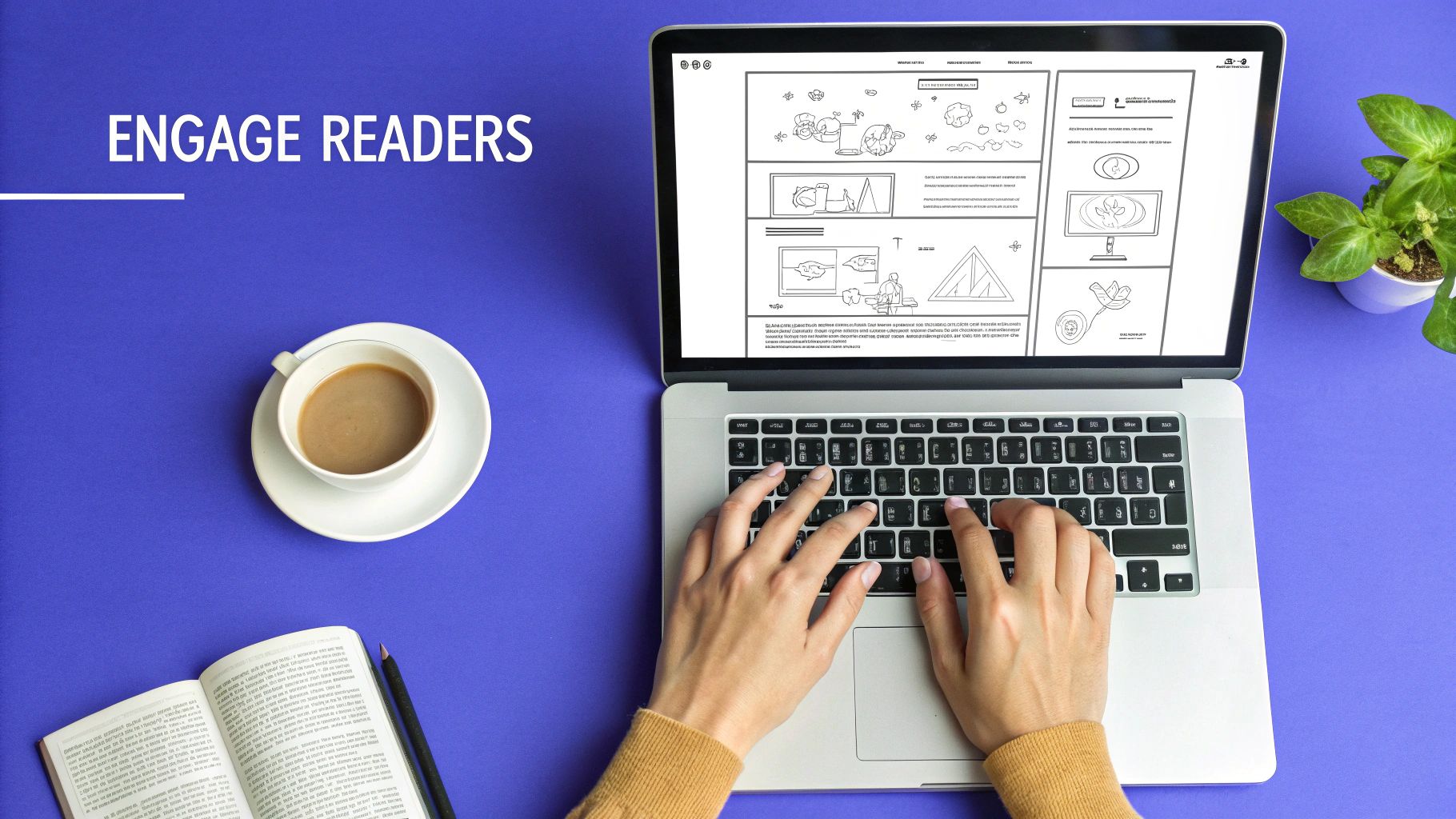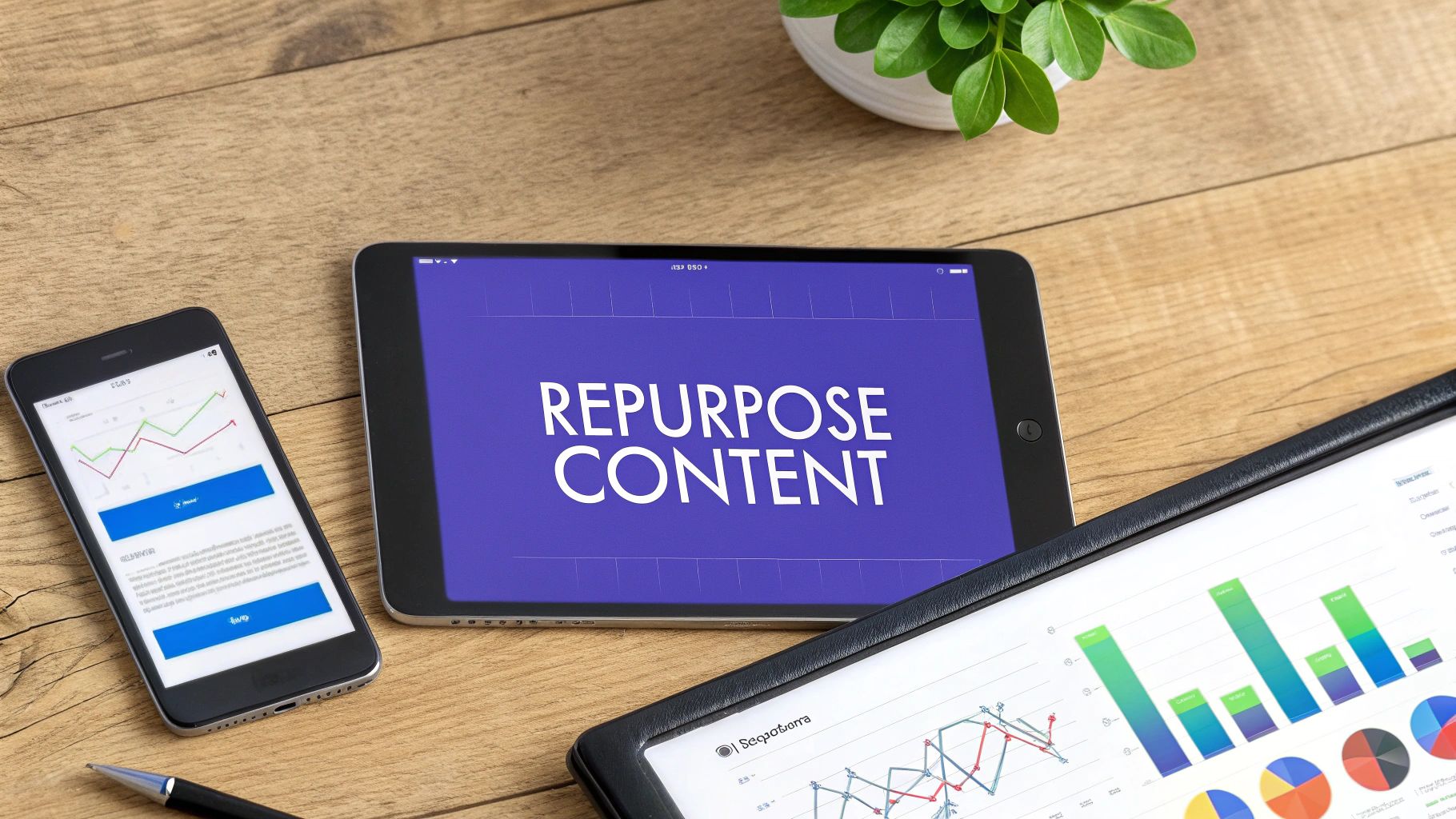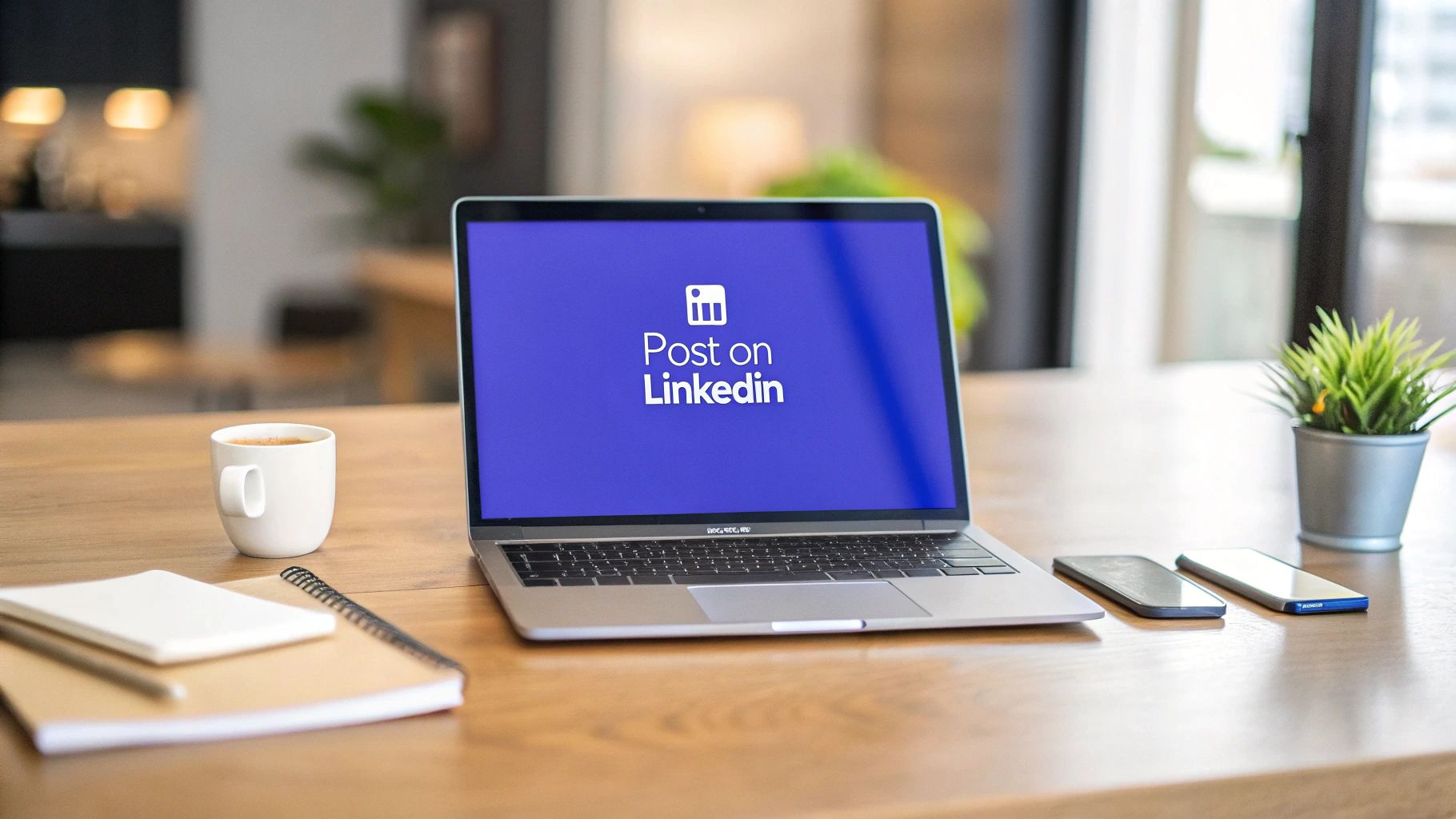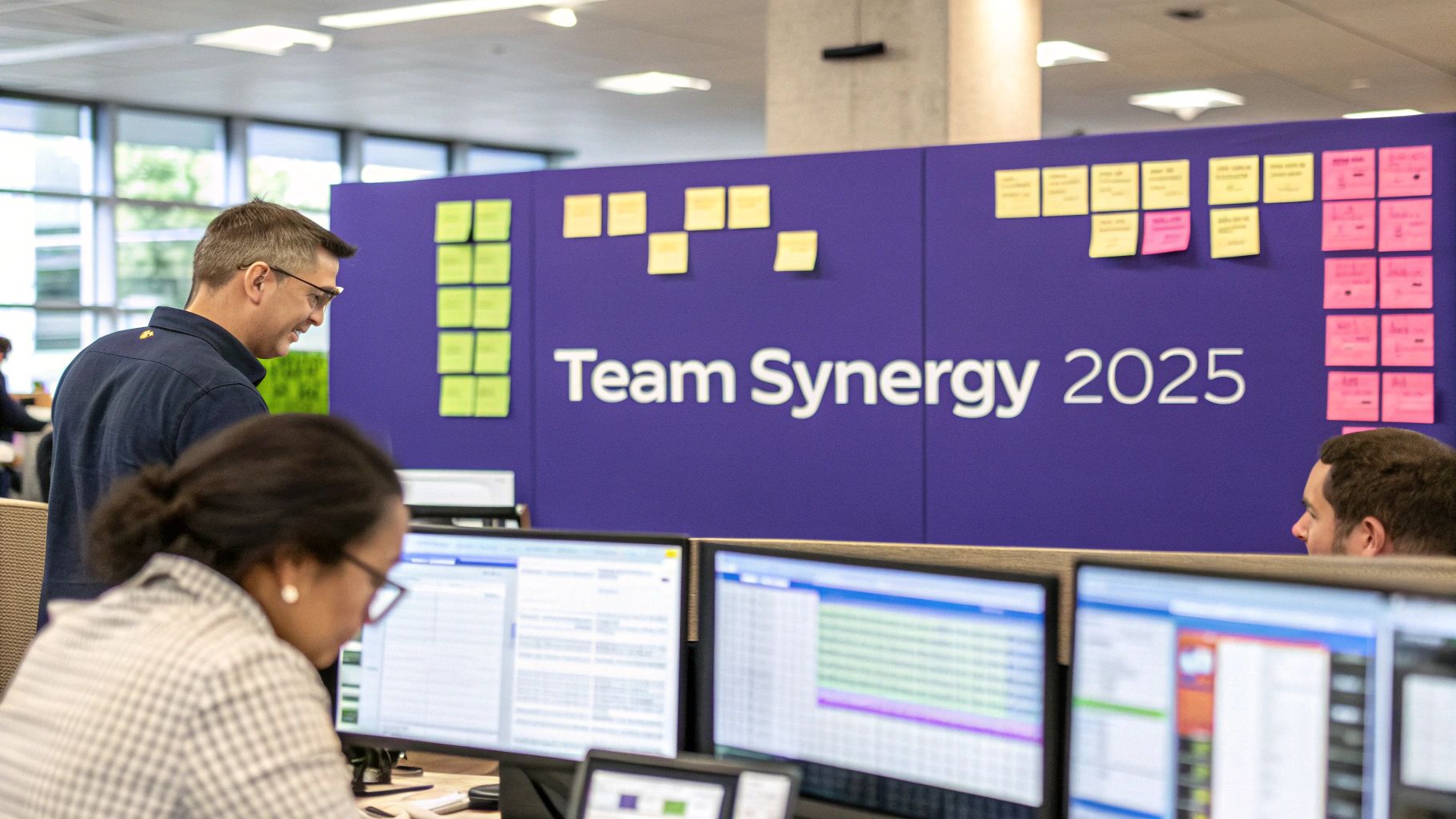So, you're ready to publish an article on LinkedIn? It’s surprisingly straightforward. From your LinkedIn homepage, just look right under the box where you'd normally start a new post, and you'll see a "Write article" button. A quick click there opens up the editor.
This powerhouse feature is available on desktop for both your personal profile and any Company Pages you manage, giving you a dedicated space for your long-form content.
Why Bother With LinkedIn Articles?
Publishing articles directly on LinkedIn is one of the smartest moves you can make to cement yourself as an expert in your field. Think about it: a regular post has a short lifespan before it's lost in the newsfeed. An article, on the other hand, becomes a permanent part of your profile. It's like building your own mini-blog, showcasing your expertise for anyone who visits your page.
This format lets you go deep on topics, share real insights, and build genuine credibility with your network. But the perks don't stop there.
- You'll Get More Eyes on Your Work: LinkedIn's algorithm loves native content, and articles often get a bigger push than posts that link to an outside blog. Your articles can even get picked up by Google, pulling in readers from well beyond the platform.
- It Builds Your Reputation as a Leader: When you consistently share thoughtful analysis and fresh perspectives, people start seeing you as the go-to person in your industry. This is a core part of how you can build a personal brand on LinkedIn that actually opens doors.
- It Can Bring in Business: A truly helpful article that solves a common problem is a magnet for potential clients. Every piece you write is a demonstration of the value you bring to the table.
Setting Yourself Up for Success
Before diving into the editor, a little prep work goes a long way. It’s like gathering your ingredients before you start cooking—it just makes the whole process smoother and the final product better.
Here's a quick publishing checklist to make sure you have all the essential components for a polished, professional article.

Having a killer headline, a high-quality cover image, and an optimized profile ready to go ensures your article makes a killer first impression. These core pieces work together to hook readers and frame your expertise from the get-go.
Mastering the LinkedIn Article Editor

Knowing where to click to start an article is one thing. But truly mastering the editor is what separates a basic text document from a polished, professional piece of content that actually gets read.
The LinkedIn publishing tool is surprisingly capable. It has a clean, minimalist interface, but underneath you’ll find some powerful formatting options designed to make your articles readable and keep your audience hooked. Think of your article less like a wall of text and more like a visual journey for your reader.
Structuring Your Content for Readability
The skeleton of any great article is its structure. LinkedIn’s editor gives you simple but effective tools to build a clear hierarchy, which is crucial for making your content scannable—especially for busy professionals scrolling on their phones.
- Headings and Subheadings: Use the "H1" (Heading 1) and "H2" (Heading 2) options in the toolbar to break your article into logical sections. This isn't just about aesthetics; it creates a clear outline that guides readers and helps them find the information they care about most.
- Text Formatting: Don't hold back on using bold, italics, and underlining. These are your tools for drawing attention to key terms, surprising statistics, or powerful quotes. Bolding a key takeaway can be the one thing a reader remembers.
- Lists: Bullet points and numbered lists are your best friends for breaking down complex ideas, outlining steps in a process, or highlighting benefits. They create much-needed white space and make information far easier to digest than a dense paragraph.
Pro Tip: Keep your paragraphs short. I mean really short. Aim for just 1-3 sentences each. This single trick dramatically improves the reading experience on mobile and keeps people scrolling.
Adding Media to Elevate Your Article
An article that’s nothing but text is a huge missed opportunity. We’re visual creatures, and adding media can significantly boost views by breaking up the monotony, illustrating complex points, and making your content stick.
The LinkedIn editor makes it easy. Just click the small square icon that pops up to the left of any new line, and you'll get several options:
- Image: Add high-quality images that reinforce your message. Ditch the generic stock photos and opt for screenshots that illustrate a process, charts that visualize data, or professional photos that fit your personal brand.
- Video: You can embed videos directly from platforms like YouTube or Vimeo. This is perfect for offering deeper context or a more dynamic explanation of your topic.
- Slides: Got a presentation on SlideShare? You can embed it directly to offer a detailed, visual summary of your key points.
- Links: While you can always add a standard hyperlink, this option lets you embed a rich link that includes a nice visual preview.
- Snippets: If you're writing for a technical audience, this is a fantastic feature. You can embed code snippets with proper formatting, adding a professional touch and immense value.
Your cover image is especially critical—it’s the first thing anyone sees. The recommended size is 1200 x 627 pixels. To get this right every time without fussing with complex software, you can use a tool specifically for the perfect LinkedIn photo resize.
A compelling cover image is like a book cover. It has to grab attention and promise value. When you combine that with a thoughtfully structured article, you create something that doesn't just inform but leaves a lasting professional impression.
Crafting Content That Captures Attention
Once you've got the hang of the editor, the real work begins. An article that’s perfectly formatted but fails to connect with anyone is just a missed opportunity. The goal isn't just to publish; it's to create something professionals actually want to read, share, and talk about.
LinkedIn is the last place you want to drop a hard sales pitch or a generic company update. The content that wins here is generous, insightful, and solves a real problem for the reader. It’s about positioning yourself as a helpful expert, not just another voice adding to the noise. Think about what your audience genuinely struggles with and build your article around a clear solution or a fresh perspective.
Proven Formats That Resonate
While originality is fantastic, you don’t need to reinvent the wheel every single time. Certain formats consistently do well because they deliver value in a structured, easy-to-digest way. Remember, professionals are busy, and they appreciate content that gets straight to the point.
Two of the most effective formats I've seen are:
- How-To Guides: These articles are gold. They walk readers through a specific process or solve a tangible problem. Think "How to Prepare for Your First Performance Review"—it offers immediate, actionable value.
- Listicles: Numbered or bulleted lists like "5 Common Mistakes New Managers Make" are incredibly scannable. They promise a quick, organized read, which is perfect for someone scrolling on their lunch break.
These formats just work. They make a clear promise in the headline and then deliver on it without a lot of fluff.
Finding the Sweet Spot for Length and Structure
It’s easy to think shorter is always better, but on LinkedIn, depth often wins. This is a platform for professional development, and people are willing to invest their time in content that provides real substance.
Key Takeaway: The articles that truly take off on LinkedIn are rarely quick reads. They are comprehensive pieces that dig deep into a topic, offering enough value to keep readers engaged and establish the author's credibility.
Some fascinating research analyzed over 3,000 LinkedIn posts and found some powerful benchmarks. It turns out that long-form content between 1,900-2,000 words generated the most engagement—a clear sign that a well-developed argument is highly valued.
The data also showed that articles structured with five headings and featuring around eight images received the most views, reinforcing the need for scannable, visually interesting content. Ultimately, the most impactful posts were the ones that sparked conversation, proving engagement is the secret sauce for visibility. You can see more insights from the full analysis of LinkedIn content performance.
At the end of the day, a successful article balances depth with readability. It goes beyond surface-level advice to provide a rich, well-structured experience that educates and sparks a dialogue. This is how you move from just knowing how to post an article on LinkedIn to publishing content that truly makes an impact. Give people a reason to stop their scroll and invest their time in what you have to say.
Optimizing Your Article for Maximum Reach

Hitting "publish" is just the start. If you want your article to actually make a difference, you need to give it a strategic push to cut through the noise on the LinkedIn feed. Think of it less like a post and more like a valuable asset that needs a solid promotional plan.
Your first move is to put on your SEO hat. Even though we're talking about LinkedIn, not Google, the core principles of discoverability are surprisingly similar. You need to make it incredibly easy for both the algorithm and your ideal readers to find your work. It all starts with the headline.
Writing Headlines That Attract Clicks
The headline is, without a doubt, the most critical part of your article. It’s what shows up in the feed, in LinkedIn search results, and in notifications. A great headline doesn't just describe what's inside; it sells the value of clicking to read it.
So, instead of a forgettable title like "Marketing Tips," get specific and keyword-focused. Try something like, "5 Content Marketing Mistakes That Are Hurting Your Engagement." This version targets a real problem and uses phrases your audience is likely searching for.
Expert Insight: Never settle for your first headline. Brainstorm at least five or six different options. Play around with using numbers, asking a direct question, or making a bold, intriguing statement. A simple headline tweak can easily double your click-through rate.
A good rule of thumb is to front-load your most important keywords. This helps the algorithm instantly categorize your content and signals its relevance to people skimming their feeds.
Using Hashtags and Timing to Your Advantage
On LinkedIn, hashtags are the primary sorting tool. They're like topic labels that help your article travel beyond your immediate network to people who follow those specific subjects. The goal is to be strategic, not spammy.
I've found the best approach is to use a mix of broad and niche hashtags:
- Broad Tags: Use 1-2 popular tags like
#Marketingor#Leadershipto cast a wide net. - Niche Tags: Add 2-3 highly specific tags like
#B2BContentStrategyor#PersonalBrandingTipsto pull in a more targeted, high-intent audience.
When you publish is just as important. Dropping your article when your audience is most active gives it that crucial initial boost in visibility. The data is pretty clear: LinkedIn engagement usually peaks on Tuesdays, Wednesdays, and Thursdays between 10 AM and noon. Plus, studies show that posting consistently every week can lift your engagement by as much as two times, making it a powerful habit to build.
Building a Simple Promotional Workflow
Once you’ve published your article, the real work begins. A simple promotional workflow ensures your content gets the attention it deserves over the long haul. Your article isn't just a one-and-done piece; it's the centerpiece of a mini-campaign. To make sure your articles are pulling their weight, it's always a good idea to stay updated on the latest best practices in content marketing.
An effective workflow can dramatically extend the life of your content. This kind of planning is the heart of a strong content distribution strategy, ensuring all your hard work reaches the right people at the right time. The goal is to create multiple touchpoints that all lead back to your main article, maximizing its reach and impact for days or even weeks.
Promoting Your Article After You Publish
That feeling of hitting the "publish" button on a new LinkedIn article is great, isn't it? But here’s the thing I’ve learned over the years: that moment is the starting line, not the finish. If you really want your article to make an impact, you need a smart plan to get it in front of people. Otherwise, even the most brilliant piece of writing gets swallowed by the endless scroll of the feed.
The best way to think about it is to treat your article as the main event—a pillar of content. From that single long-form piece, you can spin off a whole series of smaller, snackable posts that all point people back to the original. This isn't just about squeezing more life out of your work; it's about meeting people where they are.
Repurposing for Maximum Engagement
Let's be real: not everyone has the time or desire to click and read a 1,500-word article right away. But they might stop for a slick carousel or watch a quick video. By breaking down your article’s key ideas into different formats, you give yourself more shots on goal. This is where the real fun begins.
Here are a few of my go-to repurposing tactics:
- Build a Carousel Post: Pull out 5-7 of the most compelling stats, tips, or quotes from your article. Turn them into a sharp-looking carousel. Each slide hits one key point, and the final slide is your call to action: "Read the full article for more insights," with a link.
- Share a Powerful Snippet: Find a paragraph or a short story within your article that really packs a punch. Post it as a text-only update with a hook that gets people thinking or debating. Then, drop the link to the full article in the first comment to drive traffic.
- Record a Quick Video: Hop on camera and film a 60-second video summarizing the single biggest takeaway from your article. It’s personal, it’s authentic, and it grabs the attention of people who prefer watching over reading.
This multi-format strategy isn't just a hunch; it works. The data is pretty staggering—carousel posts are absolute engagement machines, pulling in 596% more engagement than simple text posts and 278% more than video. If you're a data nerd, you can dig into more LinkedIn content performance stats from Buffer.
Amplify Through Your Personal Profile
Now, let's talk about who does the sharing. It’s tempting to just push the article out through your company page and call it a day, but that’s a huge missed opportunity. The numbers tell a very different story.
Key Insight: Content shared from a personal profile absolutely crushes content from a company page. On average, you’re looking at 2.75 times more impressions and a massive five times more engagement.
Why the huge difference? It's simple: people connect with people, not with logos. When an article comes from your personal profile, it feels like a genuine recommendation from a human being. Take it a step further and encourage your teammates to share it too, but with their own commentary. That authentic, personal touch builds trust and drives way more meaningful conversations.
Planning out these follow-up posts is the final piece of the puzzle. You can map out a whole promotional calendar, and if you're curious about the mechanics, you can learn how to schedule posts on LinkedIn to keep the momentum going. A little coordination ensures your article keeps finding new readers long after you first hit publish.
Frequently Asked Questions About LinkedIn Articles

Even with the best-laid plans, a few questions always seem to surface right before you hit "Publish." Getting these sorted out ahead of time is the key to publishing with confidence and avoiding any last-minute snags.
Here are the answers to the most common questions I get about how to post an article on LinkedIn.
What Is the Difference Between a LinkedIn Article and a Post?
This is easily the most common point of confusion. Think of it this way: a LinkedIn post is a quick, short-form update that shows up in the feed. It's fantastic for sharing a quick thought, a link, or starting a conversation right now. The downside? It has a character limit and a pretty short lifespan in the fast-moving feed.
A LinkedIn article, on the other hand, is your long-form powerhouse. It’s essentially a blog post that lives permanently on your profile in a dedicated "Articles" section. You get full formatting options, and it’s the perfect way to really dig deep into a topic and establish your expertise.
Key Takeaway: Use posts for your daily engagement and quick hits. Use articles to build a lasting library of your knowledge. Articles have a much longer shelf life and can be found via search engines months—or even years—down the road.
Can I Edit My LinkedIn Article After Publishing It?
Absolutely. You can go back and edit your article at any time after it’s live.
Just head to the article from your profile, click the "Edit article" button, and make whatever changes you need. Once you’re done, hit "Publish" again, and the updated version will be live.
One crucial thing to remember: while the article link itself will always point to the newest version, the original promotional post you shared to the feed won't update with your edits.
Should I Post the Full Article on LinkedIn or Link to My Blog?
For maximum reach on LinkedIn, publishing the full article natively is almost always the way to go. The LinkedIn algorithm heavily favors content that keeps users on its platform. That means native articles typically get way more visibility than a simple post linking out to your blog.
But what about duplicate content issues with search engines? It’s a valid concern, but LinkedIn has a simple, built-in solution for when you're republishing from your own site.
- In the article editor, go to the Manage menu.
- Select Settings.
- Paste your original blog post URL into the "Original URL" field.
This simple step adds a canonical link, which tells search engines like Google that your blog is the true source and should get all the SEO credit. It’s the best of both worlds: you get the visibility boost on LinkedIn while protecting your blog's search rankings.
Ready to streamline your entire social media workflow? PostSyncer centralizes your content creation, scheduling, and analytics, making it simple to manage your brand's presence across all networks. Plan, collaborate, and publish your content with an AI-powered platform built for growth. Start your free 7-day trial of PostSyncer today.















